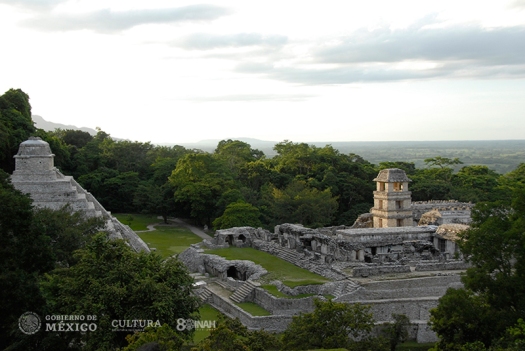The Archetypal Maya rivalry between Pakal’s Lineage of Baakal, associated with the White Heron, and the archenemy Lineage of Kaan, associated with the Serpent.
The official INAH Mexico has recently announced the results of a new epigraphic study of the Maya glyphs inscribed on the Hieroglyphic Stairway of the Palace of Lakamha’ (Palenque, Chiapas). This new reading goes deeper into the narrative of the sacred wars led by Pakal the Great against the Snake Kingdom (Kaan Kingdom), the archenemy of his sacred lineage who, in the past, not only destroyed the inscriptions and monuments of Palenque but also assassinated most of the royal line. It is now known that Pakal had a primal vendetta against the Snake bloodline, the reason why he not only captured and sacrificed his rivals, but he also desecrated the skeletal remains of the ones who attacked his city even before he was born.
In this all new Tortuga 13:20 Series, Galactic Maya researchers Gar Magusa and Itzadragon unearth and dissect some of the deepest enigmas of the Palenque Maya. Legendary events that Pakal the Great himself deemed important enough to be inscribed in stone, once again see the light.
Tortuga 13:20 are proud to be part of this unveiling, because “Reconstructing the Planet Art Legacy” does not only apply to the cultural movement initiated by the visionary work of Jose and Lloydine Argüelles. The great reconstruction extends deep into the original source of this wisdom, which is anchored in the Maya Myth of Lakamha’ (Palenque). Both authors tirelessly researched and studied the inscriptions and mythic history, transcribing and transcreating its essence into the prophetic dispensation of the Dreamspell and Telektonon. We must however understand, that at their point in the timeline, not everything about the inscribed history of Palenque had been completely deciphered.
Considering the rapid development of the Maya Epigraphy, the study of these hieroglyphs is a key to accurately understand the Maya Transmission, a historical truth which has always been inscribed. As such, we find ourselves in a unique position, because the story is still unfolding. We are witnessing in realtime the unravelling of new chapters in this enigmatic narrative.

Our purpose through this ongoing work is to Unify the Realtime with the Dreamtime. The Ancient with the Future. The Conscious with the Unconscious. Because only by bringing these streams together, can we truly understand and discern the narrative that is unfolding and that which we are being told.
This research focuses on the new decipherments of Pakal’s inscriptions on the Hieroglyphic Stairway at the House C, originally named “U Naah Chan” (“House of the First Heaven”) and situated within the Palace of Lakamha’ (Palenque). This is the story of the primal archetypal rivalry between Pakal’s lineage of Baakal, associated with the White Heron, and the archenemy lineage of Kaan, associated with the Serpent.
Pakal’s Hieroglyphic Stairway to Heaven
On 2 December 2019, the National Institute of Anthropology and History in Mexico (INAH) press released the official journal, “Boletín N° 520”, announcing the results of a reinterpretation of the Maya inscriptions on the Hieroglyphic Stairway of Lakamha’, “Place of the Great Waters” (original name of Palenque). This monument was built by Pakal the Great, who situated it at the East Court of the Palace, in what is known today as the House C. This interior building was inaugurated on Long Count 9.11.9.5.19, 4 Kawak (4 Storm), equivalent to 22 or 23 December 661 AD).

The recent ground-breaking reading of the stairway is based on an accurate new drawing of the glyphs by Ukrainian Epigraphist and INAH Collaborator, Yuriy Polyukhovych. In order to reconstruct the inscriptions, the specialist made use of the Maudslay Collection from the British Museum in London, as well as the 3D models and digital resources done by this museum in collaboration with Google Arts & Culture and the INAH.
Virtual Tour: The Hieroglyphic Stairway of Palenque on Google Arts & Culture.
As pointed out on the INAH journal, “if the British Archaeologist, Alfred Maudslay (1850–1931 / London-Hereford), wouldn’t have photographed the stairway in 1891 and made the plaster casts of the carvings, which both were used to create the 3D models by Google Arts & Culture, it would have been impossible to access its full content”.
“It was the unexpected magnificence of the monuments which that day came into view that led me to devote so many years to securing copies of them, which, preserved in the museums of Europe and America, are likely to survive the originals.”–Alfred Maudslay
The clear portrayal of the glyphs on the new drawing was a key for the INAH specialists, who were able to reinterpret the Maya verbs ubut’uuw (to bury) and u… a’n (which the researchers inferred to be equivalent to ‘unearth’). The new depiction of the inscriptions also shedded light about the details of the alliances, treacheries and historical figures enshrined on the stairway.
According to INAH Epigraphist, Ángel Sánchez Gamboa, the backstory of the Hieroglyphic Stairway narrative is focused upon “the rivalry between two Maya lineages: the Baakal lineage, set in Palenque, and the Kaanul (Kaan) lineage, first settled in Dzibanché and, after a civil war, moved to Calakmul.” (INAH Boletín 520)
The Rivalry between Baakal and Kaan
The Ancient Maya city of Lakamha’, known today as the Archaeological Zone of Palenque, contains some of the richest inscriptions of Maya Culture, a monumental and timeless transmission left by the luminous dynasty of Pakal the Great. Since the breaking of the Maya Code, and the consequent evolution of the Maya Epigraphy, the study of these hieroglyphs has been a key to accurately transcribe most of the Maya lore, a historical truth which has always been inscribed.
The antagonism between some of the Ancient Maya dynasties is a well known subject within the studies of Maya Epigraphy. Such is the case of the archenemy kingdoms of the Baakal lineage (associated with the white heron or cormorant), and the Kaan lineage (associated with the snake). The Baakal Dynasty was based on a monogamous bloodline, just as the birds generally are. The Kaan Dynasty was based on a polygamous bloodline, just as the serpents are. The archetypal contrast between these animal totems can be clearly seen on their glyph emblems.
The hostility between these dynasties started in the year 599, when the ruler of Calakmul, Lord “Scroll Serpent”, attacked the city of Lakamha’. During this important defeat, the city of Lakamha’ was overtaken, their Gods were offended and its Queen, the Lady Yohl Ik’nal (Heart of the Wind Place), was humiliated. She was the grandmother or great-grandmother of Pakal, also known for being the first female ruler in recorded Maya history.
According to the new details deciphered from the stairway, the INAH explained that “it recounts that Palenque, then ruled by the Queen Ix Yo’hl Ik’nal, suffered from the military attack by the lineage of Kaanul, still set in Dzibanché. On that occasion, ‘Scroll Serpent’ allied with the lords of Santa Elena and Yaxchilan, Nuun Hix Lakam Chahk and Itzam Kokaaj Bahlam respectively, in order to humiliate Palenque and its patron gods”.
Through this attack, the Snake Kingdom not only slandered the tutelar gods of Palenque, which we know were led by GI (God I) associated with the Tzolkin day of 9 Ik’ (Bolon Ik, 9 Wind), but they also humiliated the Queen “Heart of the Wind Place,” an evident lineage holder of the same Wind Cosmology of Bolon Ik.
The defeat of Palenque in 599 initiated a long-lasting conflict between Lakamha’ and Calakmul, bringing great instability to the lineage of Baakal, whose dreams of independence were again suffocated by the Snake Kingdom in the years 605 and 611, causing the deaths of the most important nobles of the Baakal lineage.
According to the reinterpretation by INAH:
“In this time (611 AD) Palenque had established its supremacy in the region of Tabasco but the ruler ‘Scroll Serpent’ of Dzibanché, once again attacked and won.”
As pointed out by specialist Ángel Sánchez, the new reading of the stairway infers that “between the years 612 and 659, constant adjustments occurred at a regional level, and Santa Elena once again betrayed Palenque and allied with Dzibanché-Calakmul, which resulted on the overwhelming revenge of Pakal.” (INAH Boletín 520)
Pakal’s Vendetta against the Snakes
K’inich Janaab’ Pakal was born on LC 9.8.9.13.0 – 8 Ajaw (23 March 603), around 4 or 5 years after the first attack to Palenque in 599. From a very young age, the young prince Pakal personally experienced this particularly violent time in the history of Lakamha’. He was only 2 years old for the second attack to Palenque in 605, when a new puppet ruler was installed by the Snake Kingdom. He was between 8 and 9 years old for the attack in 611.
As a child, Pakal was forced to live in exile, until his mother, the Lady Sak K’uk’ (White Quetzal), was able to install him as the “Divine Lord of the Kingdom of Baakal” at the age of 12. Pakal’s Accession to the Throne was recorded on the Oval Tablet on Long Count 9.9.2.4.8 – 5 Lamat (5 Star), date equivalent to 26 or 27 July 615 AD.
Pakal was thus a survivor of the bloodline which the Snake Kingdom almost destroyed. Logically, the new King became responsible of the re-construction of the legacy of Lakamha’, focusing on the monumental architecture of Palenque and the notable inscriptions about the divine lineage of Baakal. His mission was firmly continued by his descendants.
In light of the new details shed by the INAH reinterpretation, in the year 659 Pakal initiated a war against the kingdom settled in Santa Elena, the one which helped the historical attacks of Calakmul to Palenque.
“Pakal not only captured the ruler of Santa Elena, Lord Nuun Ujol Chahk, but he also profaned and exhibited the skeletal remains of Nuun Hix Lakam Chahk, who participated in the original invasion to Lakamha’ in 599 AD, five years before Pakal himself was born.
“Through this little known act until now, Pakal punished the past and present offences against his kingdom and, at the same time, he turned his victory against Santa Elena in a propagandistic narrative reflecting his power.” (INAH Boletín 520)
The study also established that the revenge of Palenque included the captivity of other Maya rulers across Tabasco, among which the ruler of Pomona stands out. Actually, the group of royal prisoners is depicted on the piers around the Hieroglyphic Starway, which inscriptions indicate that they were “trophies of Bolon Yokte K’uh”, the deity of the sacred wars of Pakal and tutelary God of the House C.
“The royal captives were taken to Palenque were they had an unfortunate end because on the West Tablet of the Temple of Inscriptions says that Nuun Ujol Chahk, along with his local deities, was turned into food for the gods of Palenque…” (INAH Boletín 520)
This military campaign was used by Pakal as a propaganda of one of his most important achievements, as reflected across the narrative of all his inscriptions. After his triumphs in 659 and 662, he even dedicated the East Court of the Palace (Houses B, C and A) as a ceremonial zone to highlight the military victories against the Snake bloodline. He gave special attention to the Hieroglyphic Stairway at the House C known as “U Naah Chan” (House of Heaven).
Note: “Naah Chan” is not the “House of the Serpent” but the “House of Heaven”

The original Maya name of the House C at the Palace of Lakamha’ (Palenque) is “U Naah Chan”, which means “House of the First Heaven” or “House of Heaven” (Guillermo Bernal, INAH). During the 80s and 90s, the Maya Epigraphists believed that “Naah Chan” was the name of Palenque and/or the name of Palace due to the amount of inscriptions that Pakal left in this House. However, since over a decade it is known that “Naah” means “House” and “Chan” means “Heaven” within the context of this inscription (Guillermo Bernal, INAH). For these reasons, it is a fundamental error to refer to Palenque as “Naah Chan” and, on top of that, to translate it as “House of Serpent”.
Therefore, the original name of Palenque is Lakamha’, “Place of the Great Waters”, and the House C of the Palace, inscribed with the name of Naah Chan, means the “House of Heaven”.

Reconstructing the Divine Lineage of Baakal
Pakal’s fundamental mission as a ruler was to re-construct the divine lineage of Baakal by embedding the mythic storyline through majestic monumental architecture, piers and inscriptions. A planet art legacy of Maya Cosmology that has stood the ‘test of time’ and amazes until today.
The sacred wars of the Maya lineages were more than a just fight for power, they were an existential conflict for the survival of the cultural history and accumulated myth of the lineage. As Winston Churchill famously stated, “History is written by the victors”, and thus, Pakal’s vendetta against the Serpent bloodline manifested as both an urgent defence and “reconstruction” of the Baakal lineage. We must therefore appreciate that Pakal’s revenge against the snakes, is ultimately responsible for the preservation of Maya Lore that we draw upon today.
Pakal’s narrative against the Snake lineage of Kaan is also depicted on Pier D of the Palace of Lakamha’, where a young King Janaab’ Pakal and his wife, the Queen Tz’akbu Ajaw, represent the Primordial Mother and Father of the Re-constructed Dynasty, holding firmly a serpent in order to decapitate it with the axe of the “Divine Lord of the Baakal”.
In this way, Pakal’s message to the world stands as a universal teaching of the spiritual battle against the Cultural Genocide. Had Pakal have not succeeded in his war against the Snakes, the abundance of codes that are embed into the Long Count Maya Tzolkin Calendar, the Dreamspell, Telektonon, 19:19 Crystal Matrix and others would quite simply not exist today. Not to mention the spiritual teachings they bring. Had they not have been inscribed by Pakal, we would never have found them.
So we must give honour and gratitude to Pakal, to the Bolon Ik lineage of the White Heron, to the honourable scribes who followed the guidance of their leader, and to the great scientists and archaeologists, in particular to Alfred Maudsley for decoding, documenting and saving this mythic history as a patrimony of humanity.
The evolution of human consciousness is a collective effort through history.
“Those who do not learn from history are doomed to repeat the same mistakes…”
In the next part of this series, we will take a closer look at moral and spiritual differences between these two lineages, and how the attack of the Snake kingdom against the cultural legacy of Baakal is a common tactic that has been used throughout the timeline of humanity. Much Gratitude for Tuning In ❤
Galactic Maya Series presented by
Gar Magusa (Kin 34) & Itzadragon (Kin 21)
Published on:
7 December 2019 – Magnetic Wizard Year Moon 5 Day 23 – Telektonon Unit 23 “Lovers ReUnion” – DreamTime Kin 148 (5 Star = 5 Lamat, Pakal’s Accession & Future Return) – Yellow Seed Wavespell – Maya RealTime 11 Ik’ (11 Wind coded 2.11 = 11:11)
References
- INAH (2019). Ahondan en las guerras lideradas por Pakal, a partir del estudio epigráfico de la escalera jeroglífica de Palenque. Boletín No. 520 (2 Diciembre 2019). See Press Release.
- Bernal Romero, Guillermo (2011). El señorío de Palenque durante la Era de K’inich Janaahb’ Pakal y K’inich Kan B’ahlam (615-702 d.C.). Disertación doctoral, INAH, México.
- Martin, Simon; Nikolai Grube (2000). Chronicle of the Maya Kings and Queens: Deciphering the Dynasties of the Ancient Maya. London and New York: Thames & Hudson.
- Magusa, Gar (2017). The Telektonon Trinity: Part 4D. The Realtime Dreamtime Prophecy. Avebury: Magikana Publishing UK.
- Schele, Linda; David Freidel (1990). A Forest of Kings: The Untold Story of the Ancient Maya. New York: William Morrow.
- Schele, Linda; Mathews, Peter (1998). The Code of Kings: The Language of Seven Sacred Maya Temples and Tombs. New York: Touchstone.
- Stuart, David; Stuart, George (2008). Palenque: Eternal City of the Maya. London: Thames & Hudson.
- The British Museum (2019). The Hieroglyphic Stairway of Palenque. Google Arts & Culture.
- The British Museum (2019). Maya Heritage: 150 Years of Preservation. London: The British Museum Blog.
- Wikipedia (2019). The Snake Kindgom of Calakmul.














Muy bello relato, amplía muchos conceptos y profundiza otros… Geniales, los adoro.
Caco.
Sirena, Curanipe.
5 Lamat.
LikeLiked by 2 people
Muchas Gracias Caco! Aquí disponible en Español. In Lak’ech https://tortuga1320.com/2019/12/07/serpientes-escaleras-parte-1-sagrada-venganza-pakal-inscrita-escalera-cielo/
LikeLiked by 1 person
Reblogged this on GM1089.
LikeLike
Reblogged this on Planet Art Network and commented:
Truth is always Inscribed !
The Planet Art Legacy of Lakamha’ (Palenque).
Understanding the Archetypal Maya rivalry between Pakal’s Lineage of Baakal (associated with the White Heron), and the archenemy Lineage of Kaan, associated with the Snake.
LikeLiked by 1 person
Si para mi fue muy especial, por que aquel día, antes de que este escrito llegara a mi, en el humedal donde habito, aparecieron en vuelo 10 garzas blancas y comentaba con un alumno, las facultades que llevaron a la entronización de Pacal y la profundización de sus estudios psicoastronómicos… Bendiciones bellas para todos.
LikeLiked by 3 people
Bravo 🙏🏼🌈
The history is from the winners but on the Long time so need of morality 💚🦌
LikeLike
Great blog I eenjoyed reading
LikeLike